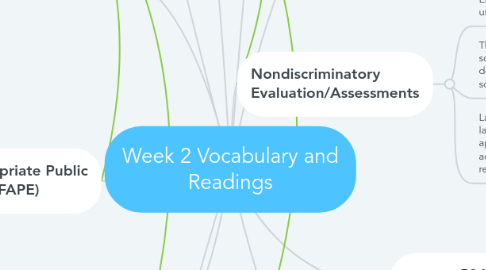Week 2 Vocabulary and Readings
by Callie Mowers

1. Individuals with Disabilities Education Act (IDEA)
1.1. Renamed to this in 1990.
1.2. Transitional supports from middle school to high school.
1.3. Addresses disciplining students with disabilities.
1.4. The expansion of parent participation.
1.5. Clarification of the roles of general education teachers for special education students.
1.6. Says how to resolve disputes with parents.
2. Least Restrictive Environment
2.1. HOW students receive FAPE
2.2. They must be educated within a setting that is relative to their peers without disabilities.
2.3. Must have the supports and services that they need.
3. Rights to Confidentiality
3.1. Information about the child can only be given to those who work directly with the child.
3.2. Log kept to track who had access to child's records.
3.3. Parents have right to see records and logs.
4. Zero Reject
4.1. Entitles all students the right to a public education no matter their disabilities.
4.2. Find children with disabilities.
4.3. Guides school policies.
4.4. Child find system: a set of procedures to find children with disabilities AND find services that are available to students with disabilities.
5. Free Appropriate Public Education (FAPE)
5.1. Education for the disabled is FREE- no acceptions
5.2. Their education must incorporate instruction that is designed for their disability. They must receive the accommodations and services that they need.
5.3. Individualized Education Program (IEP)
6. Procedural Safeguards
6.1. Any decisions regarding the student must be made with parent and their input.
6.2. Parental written consent.
6.3. Steps to follow when there is a parental dispute.
7. Special education vs. General education
7.1. General education is typical form of education that is given to children who who do not have any disabilities.
7.2. Special education is the type of education that is given to children with disabilities. Special education ensures that these individuals are getting the help, aids, and services that they need in order to reach their full potential.
7.3. Related Services: those supportive services that are given to the disabled child to help them to reach their potential.
7.4. Supplementary aides and services: given to disabled children to help them thrive in a general education classroom
8. Education of the Handicapped Act
8.1. The basis of all special education practice.
8.2. Funded disabled children who were not attending school.
8.3. Mandated states to follow laws to ensure funding for special education.
8.4. Still enforced today and are essential.
9. Nondiscriminatory Evaluation/Assessments
9.1. Ensures that all assessments are unbiased.
9.2. This is an IDEA principle that requires schools to evaluate students fairly to determine if they have a disability and, if so, what kind and how extensive.
9.3. Law ensures that: tests are given in native language, tests are age and characteristic appropriate, more than one test administered, professional assesses results, and tests all areas.
10. Section 504 of Rehabilitation Act of 1973
10.1. No handicapped person should be excluded from anything.
10.2. Accommodations must be made for them to participate.
10.3. Defines disabilities as impairments that limit the persons abilities.
10.4. Services and supports must be paid for by school district.
11. Americans with Disability Act of 1990
11.1. Protects all people with disabilities.
11.2. Accommodations in public places such as access to ramps.


